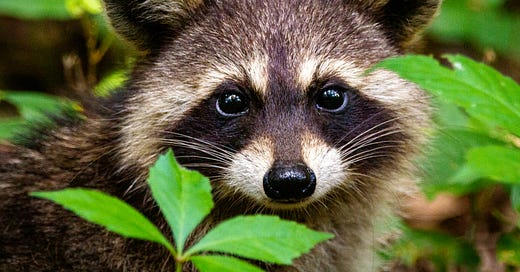Guardians of the Galaxy Did What Horror's Been Doing for Decades
Animals in Fiction, Pt. 4: Creature Features & Eco-Horror
On the placid Pacific waters off the Peruvian coast, a fisherman bobs on his caballito, a little boat of woven reeds. Though only 28, he’s one of few left still holding on to the old ways; most others have abandoned native fishing practices for trawlers, floating oceanic farms, and fishmeal and fish oil factories. But the once-abundant shoals are now scant.
Before colonization, shamans made sacrifices to the gods for good catches and good weather. As he waits for a fish to swim into his net, the man wonders who will have to be sacrificed now to stop the overfishing.
Moments later his caballito is dragged underwater, and he succumbs to the wrath of the creatures he’d been killing all his life.
This comes from the opening pages of Frank Schätzing’s The Swarm, a German bestseller first published in 2004, and later reproduced in a 2023 miniseries. As the story continues, deaths by marine creatures mount, and humanity is forced to reckon with the violence they’ve inflicted on their aquatic kin.
It is but one of myriad stories of animal revolt: The Birds, Rise of the Planet of the Apes, Frogs, The Bees, White God, and James Patterson’s Zoo, which also spawned a cable TV show. But it was built upon decades of horror stories about the oft-violent connection between humans and nonhumans…
The post-atom bomb world discovered a newfound fear in radiation, leading to numerous kaiju creature features like Them!, Godzilla, and Food of the Gods. As the Cold War progressed and the hippie movement grew, concerns over environmental destruction came to the forefront. Classics like Creature from the Black Lagoon, The Fly, and Planet of the Apes paved the way for the modern anthropomorphic creatures of The Shape of Water, The Descent, and Sweetheart.
Of the countless animal attack films following in the wake of Jaws, many directly implicated human negligence or recklessness: Day of the Animals, Long Weekend, Orca, Piranha, Empire of the Ants, Arachnophobia, Humanoids from the Deep, Killer Crocodile, Ticks, and Deep Blue Sea, to name a few. These themes carry through to modern natural horror films like Nope, Crabs!, and The Black Demon.
Many stories put humans in the roles animals typically take in society. The Most Dangerous Game, The Hunt, and even the average slasher flick all place groups of people in the vulnerable position of being hunted for sport. Cannibal films are even more visceral. You can’t watch The Texas Chain Saw Massacre, The Green Inferno, or Raw—or read Tender is the Flesh, Bones & All, or A Certain Hunger—without thinking about what meat really is. Pushing the envelope further, a modern mad scientist in The Human Centipede mutilates three people to transform them into a pet. The only non-English speaker is placed at the “head” of this abomination; though he is certainly not voiceless, his attempts at communication are easily ignored.
Several non-horror stories of the 1970s and ‘80s—like animated movies The Plague Dogs and Watership Down (both based on books)—nonetheless left audiences disturbed after seeing realistic atrocities committed upon animals by regular human activities. Animal-POV novels of the prior century—like Black Beauty, Beautiful Joe, Bambi, and Jack London’s Jerry duology—doubtless influenced these tales of animal protagonists facing down realistic horrors of humanity.
It’s been nearly a decade since I watched a Marvel movie, but Guardians of the Galaxy Vol. 3 first came to my attention in Wayne Hsiung’s heartfelt newsletter earlier this year; more recently, Mariann Sullivan of Our Hen House also penned a piece on it. Both discussed the film’s opening scene: Rocket the raccoon’s origin story, showing how he acquired his human personality in a research lab.
Though often untouched in mainstream stories, vivisection has been a trope of the horror genre since at least the 19th century with The Island of Doctor Moreau. Similarly, themes of vegetarianism flow through Frankenstein, and Dracula continues to influence modern shapeshifting vampires.
Superhero stories can hardly be called niche anymore, being some of the biggest blockbusters today, but Guardians continued a long tradition of genre fiction—primarily horror and sci-fi—tackling issues often unrepresented in the mainstream.
While horror often deploys nonhuman creatures to stoke fear in its audience, the genre also flips the script by showing us that “normal” humans are capable of far more abominable acts than the “monsters.”
On my mind: The Stranger
It’s rare to have a vegan character star in a movie where they aren’t forced to defy their morals to defeat the monster, but that’s what happens in The Stranger. A 2020 Quibi show re-released to Hulu this year, the protagonist’s veganism largely lies dormant as she’s chased in a cat-and-mouse game by her misogynistic tormenter.
In the final act, the villain escapes by setting up a bolt gun decoy device in an old slaughterhouse. A no-name cop explains to his superior how bolt guns are used to kill cattle, which feels like forced exposition…but also like something a vegan would slip in.
When our leading lady tracks down the antagonist in the film’s final scene, she decides to leave him, not lowering herself to his level by killing him. A group of coyotes come to finish him off, and he screams, “I’m on top of the food chain! You cannot eat me!” as Sia’s rendition of California Dreamin’ plays.
Am I making connections where there aren’t any, or is this secretly a vegan film?
be conscious, be kind, be vegan




